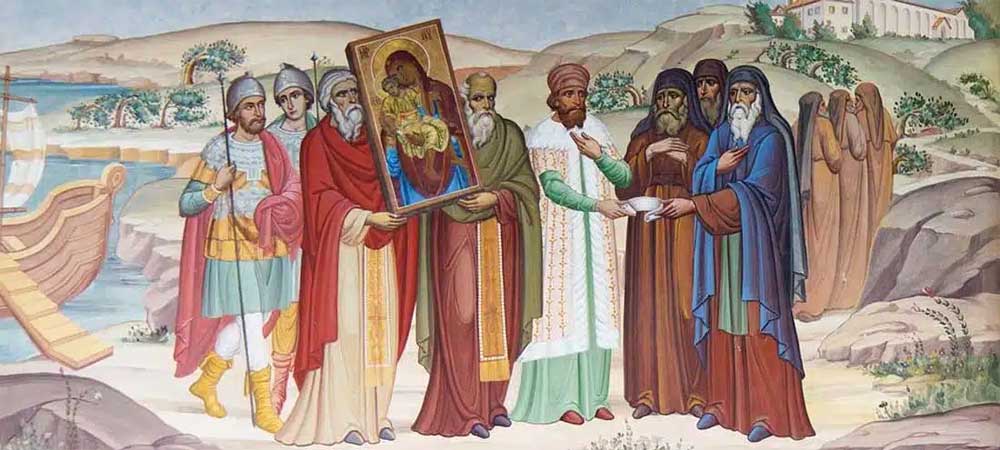Life of Saint Athanasius
 Saint Athanasius of Alexandria was Patriarch of Alexandria. He is honored as a saint by the Orthodox Church and by the Roman Catholic Church. He is one of the four great Fathers of the Orthodox Church and one of the 33 Fathers of the Roman Catholic Church. At the age of 25, he was ordained a deacon by the bishop of Alexandria, Alexander, whom he followed at the First Ecumenical Council in 325, in Nicaea, Bithynia.
Saint Athanasius of Alexandria was Patriarch of Alexandria. He is honored as a saint by the Orthodox Church and by the Roman Catholic Church. He is one of the four great Fathers of the Orthodox Church and one of the 33 Fathers of the Roman Catholic Church. At the age of 25, he was ordained a deacon by the bishop of Alexandria, Alexander, whom he followed at the First Ecumenical Council in 325, in Nicaea, Bithynia.
There he emerged as a pioneer in the condemnation of Arius’ teaching which was characterized as heretical. In 328 and at the age of 33, he was elected patriarch of Alexandria.
Saint Athanasius who was also named Megas was born in Alexandria, Egypt in the 3rd century AD. His parents were Christians and little Athanasius showed his inclination for the priesthood from a young age since it is said that he was playing with his friends and he was baptizing them in the name of Christ.
He later acquired his theological knowledge from the Theological Catechetical School of Alexandria. At that time he also met Saint Anthony, whose life and miracles he wrote later.
In 325 AD he is ordained a deacon and actively participates as secretary in the First Ecumenical Council. In 328 AD, the spiritual father and bishop of Alexandria, Alexander, dies, where he was ordained a bishop with the unanimous approval of both the clergy and the people.
He was ordained only at the age of 33. He strongly developed anti-heretical activity, with the aim of spreading the “correct” doctrine of the consubstantiality of the Father and the Son.
Athanasius the Great was also called a “pillar of orthodoxy” and was a bishop for 46 years. He spent 17 of them in exile.
The Arianists succeeded in slandering Athanasius because of his militancy in the First Ecumenical Council but also his militancy against them. The bishops agreed with the positions of Arius and sent a delegation to the Emperor Constantine accusing Athanasius of taxes in favor of the church, of witchcraft and fornication.
Athanasius at the Council of Tire found himself in a difficult position receiving messages against his life. He went to Constantinople to see for himself and explain his position to the emperor but he did not accept him. they had convinced him with false accusations. thus he went into exile for the first time which lasted two years and four months. He returned in AD 337 after the death of Emperor Constantine.
However, the slanders did not stop and as a result the new Emperor Contantius, a pro-Aryan exiles him to Rome where his innocence is proven. Nevertheless, returning to Constantinople, he was exiled again for six years this time.
In 356 Constans, brother and co-emperor is assassinated, Constantius is now emperor of the Western and Eastern parts and the Arian bishops see this opportunity and act decisively.
They call a council, depose Athanasius and send an army of 5000 soldiers with Romanus the Syrian, to exterminate him once and for all. He himself flees to the desert, where for six years he eludes capture with the help of monks and virgins.
After the death of Constantine the emperor, Julian was proclaimed. He immediately recalls all the exiles together with Saint Athanasius.
The emperor Julian, however, is a lover of the ancient spirit, he dreams of rebuilding the Roman Pantheon, and Athanasius resists bitterly. The result is that he was exiled again, this time to Thebes in 364 AD
While he returned after the death of Julian the so-called ‘Paravatis’, he continued his work uninterruptedly during the reign of Jovian until his death in 364 AD. His successor Valentinian I, who was a follower of Arius, expels Within four months, because he feared an uprising of the inhabitants of Alexandria, he recalled Athanasius from exile. From then on, he remained on his throne, without persecution.
